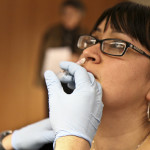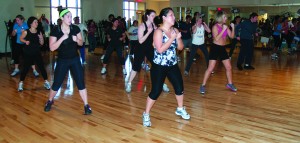by Michelle Sutton-Kerchner
It’s starting. The ads for cold and flu remedies, tissues, and canned soup. The appearance of flu-shot clinics. The first chorus of sneezes and sniffles not assumed to be allergies. Don’t fear it. Fight it …
As flu season approaches, immunization becomes a hot topic. Some routinely get an annual flu shot; others debate and hesitate until time runs out or they get hit with the flu. The Centers for Disease Control and Prevention (CDC) recommend a flu vaccination for everyone ages 6 months and older.
The flu vaccine’s effectiveness varies every year as experts try months in advance to determine which viruses will circulate. The task is made more difficult during years when more than one flu virus is spread. Regardless, protection is still advised. If the strains contained in the current season’s concoction are not a perfect match, it still helps.
This year, additional options are available. Consumers love choices. Deciding whether to have your vaccine jabbed, sniffed, with eggs, without eggs, or mega dosed allows an element of control. This is especially comforting for the individual undecided about vaccination, or fearful of needles. By utilizing free-market consumerism, pharmaceutical companies hope for better compliance with the CDC’s recommendation. With the power in the people’s hands, physicians need to provide a bit more guidance than in year’s past.
New This Year
Before getting the flu vaccine this year, consider your options. Discuss them with your healthcare provider and decide what is right for you.
 Three-strain vaccine: The standard and most popular choice in the United States, this vaccine is manufactured using a virus grown in eggs. It is injected into the muscle, often in the upper arm. It protects against two influenza A viruses and one influenza B, and is approved for ages six months and older.
Three-strain vaccine: The standard and most popular choice in the United States, this vaccine is manufactured using a virus grown in eggs. It is injected into the muscle, often in the upper arm. It protects against two influenza A viruses and one influenza B, and is approved for ages six months and older.
Four-strain vaccine: New this year, this is the standard vaccine (per above) with an additional strain of B virus added. Ideally, this will increase protection with its coverage of four strains instead of three. Experts predict vaccines of future years will be the four-strain variety.
High-dose vaccines: These offer four times more antigen than regular flu shots to assist those with a sluggish immune response. It safely protects against three strains but does so more powerfully than the standard shots. It is recommended for those 65 years and older since age naturally decreases one’s immune response.
 Nasal spray vaccine: This remains the preference for those with fear of needles. A mist of vaccine is sprayed into the nasal passages. It is available for those in good health and between the ages of two and 49 years, with the exception of pregnant individuals. In keeping with the trend, it contains protection against four strains this year.
Nasal spray vaccine: This remains the preference for those with fear of needles. A mist of vaccine is sprayed into the nasal passages. It is available for those in good health and between the ages of two and 49 years, with the exception of pregnant individuals. In keeping with the trend, it contains protection against four strains this year.
Tiny needle vaccine: Needle phobia is not limited to the young. For those 49 years and older who are no longer eligible for the nasal spray, this vaccine uses a needle 90 percent smaller than the standard flu shot. It is only injected into skin, not muscle, easing post-shot soreness as well as immediate sting. It protects against three strains of flu virus, and is approved for ages 18 through 64 years.
Egg-free vaccine: The increase in egg allergies led to the development of this year’s new egg-free vaccine. Grown in caterpillar cells (honestly), this three-strain vaccine is available to those who are between 18 and 49 years old and allergic to eggs.
These expanded options make it difficult to deny the importance of flu vaccines. Much time, effort, and financial support is dedicated to this worldwide investment. It gives even the most skeptical a reason to consider flu vaccination.
Get Off the Couch or You May Be Stuck There
Up to 20 percent of the United States will get the flu. That’s a lot of people. In addition to practicing healthy habits, physical activity also supports your immune system. Too many days lazing around may turn from a luxury to a necessity when colds, flu, and other viruses weigh you to the couch. The solution: Stay active.
Those who do not find time for exercise will have to find time for illness. This wise proverb covers everything from the common cold to more serious diseases. Being consumed by a fast-paced lifestyle is not an excuse. Keep your stamina and health strong with a regular fitness routine. Consistent exercisers lower their susceptibility to illnesses, and improve their recovery when they do succumb. Symptoms tend to be milder and shorter in duration.
How Exercise Fights Germs
Extensive research proves the link between exercise and improved immunity. However, there are several theories of explanation. A combination of benefits are likely the reason.

During exercise, the body’s systems accelerate. Heart rate increases. This circulates infection-fighting white blood cells, and other helpful components of the immune system, more quickly through the body. Happily pumping through the body, reaction time to potential infections may be reduced. Germs are zapped before they have a chance to attack. Get your heart rate elevated regularly (within healthy limits, of course).
The increased body temperature that accompanies a good workout is considered to have similar fighting power as a fever. When sick, a fever is the body’s attempt to burn off germs. Infections often cannot survive a few-degree shift in temperature. Hence, the theory of letting a fever do its job (no treatment) as long as within reason and discomfort is not extensive.
Workouts sweat out toxins. Increased thirst and being conscious of sufficient fluid intake leads to further flushing of waste from the body. An elevated breathing rate helps force bacteria and particles from the lungs. Less waste in the body lowers the risk of infection. Exercise acts as a purifier as it helps your body filter and remove impurities and germs before they cause trouble.
There is nothing like pumping iron or kickboxing the stress from your system. Exercise reduces cortisol (stress hormones), and increases serotonin and endorphins (feel-good hormones), for a happier body and brain. Stress makes one more susceptible to illnesses. Those who enjoy a positive outlook and stress-free mood tend to get sick less.
Aside from the scientific, perhaps it is simply the camaraderie shared. Friendships form, often based on the commonality of exercise routines shared. Socialization is a fun perk of Center membership. Then, there is the downtime, the chance to shut off from the outside world and all its stressors. Through fitness, you make time for yourself. Health becomes your priority. (No one wants to blow a streak of excellent workouts with a string of nights spent watching late shows while chugging beer and munching chips.) You inspire the healthy lifestyle that often accompanies fitness.
Quick Tips to Stay Healthy
 Aside from a flu shot and fitness routine, small healthy habits throughout the day can help prevent sickness.
Aside from a flu shot and fitness routine, small healthy habits throughout the day can help prevent sickness.
- Wash hands properly and often. Use soap, warm water, and a fresh towel for drying.
- Avoid touching your face. Germs can enter the body through eyes, nose, and mouth. Don’t give them the direct connection.
- Use a well-maintained humidifier in your home during cold months. Keep adequate moisture in heated air to help avoid colds, sore throats, and coughs.
- Use air filters to clean air of small dust particles and allergens, which can trigger or exacerbate sinus and respiratory conditions.
- Eat well. Focus on foods that boost the immune system: brightly colored produce, yogurt, green tea, small portions of lean meat, and garlic.
- Limit sugar. The sugar in a can of soda is thought to suppress immune function by 30 percent for three hours. Wow!
- Drink plenty of water and clear beverages. Avoid caffeine, although acceptable in unsweetened teas.
- Get plenty of sleep. Studies prove seven to eight hours of sleep per night reduces susceptibility to colds and viruses.
- Keep hands moisturized. With all that washing and use of hand sanitizer, skin easily becomes chapped. This creates cuts and cracks, which give germs more access.
Sources
www.cdc.gov.
“Exercise and Immunity,” at www.medlineplus.gov.
Image Credits
Stay healthy (introductory photo): www.flickr.com/photos/aryaziai/8533712598/
Arm shot: www.flickr.com/photos/europedistrict/4092914530/
Nasal: www.flickr.com/photos/europedistrict/4092918764/
Hand washing: www.flickr.com/photos/arlingtonva/4314530838
 Fitness & Wellness News Your Source for Fitness News, Wellness News, Health News, and Nutrition News!
Fitness & Wellness News Your Source for Fitness News, Wellness News, Health News, and Nutrition News!




